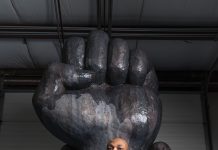
At her work bench, Kim “Zii” Thomas feels a little bit less anxious. Keeping her torch burning brightly throughout the pandemic has helped. She’s poured herself into a new body of glass sculpture that’s all about escapism in the most surreal sense. It’s called “The Escape.” Think something conjured up in the writing of Roald Dahl. What if we could build a machine, attach it to the clouds, and float away? It’s the dreamy getaway that an artist like Thomas can physically manifest, transforming borosilicate glass into works of art from behind a torch that reaches up to 5,000 degrees Fahrenheit.
“I think that the world is this really beautiful place, and then you look down here at ground level and it’s just so disappointing sometimes,” Thomas says. She’s standing between her torch and her kiln at the Urban Pheasant Glass Studio, a loose collective of glass artists lined up side-by-side inside the Russell Industrial Center in Detroit.
The creative process offers some relief for Thomas and her studiomates, but stress has still found its way into their space from time to time.
“As an artist, you are stressed out because you literally have to make every single cent,” Thomas says. “We come here every day and make something out of nothing.”

That relationship with anxiety feeds her aesthetic. There’s fantasy in her concepts, but it’s a gruesome realism that sets Thomas’ work apart. The glass teeth she makes are so close to anatomically correct because she once worked as a dental assistant. The colors and patina she creates on a sculpture of a severed finger come from her days doing special effects makeup. In a field dominated by colorful swirls and smooth shapes, few if any artists are creating work that looks like hers.
“It’s outsider art,” she says. “I’ve tried that real-world living. I can’t acclimate. I’ve got to do art.”
And like the glass itself, Thomas transformed herself a few times along the way before her cloud-flying contraptions landed in Detroit nearly two years ago.
The 43-year-old artist went to the Rhode Island School of Design, where she studied ceramics. After floating through a handful of careers, she landed in flameworking because of a Craigslist ad she answered while living in Philadelphia. “I just needed a job,” she says. “I was broke.”
And now, for the past 11 years, she’s made a living with her torch by creating and teaching. Her art has caught the eye of curators at the Smithsonian American Art Museum. Some of her work is kinetic sculpture — functional glass marionettes in the form of a werewolf or a bird of prey that look like they could live inside of a Stephen King novel. She’s featured in the group show Glass in the Expanded Field at the Hunterdon Art Museum in New Jersey. It’s on display virtually now through April 18.

The exhibition is a showcase of artists pushing the boundaries of glass art, which primarily functioned as an industrial medium in the U.S. until the 1960s. By the 1980s, glassblowers crafting functional smoking utensils arrived on the scene. Today, artists like Thomas are pushing the medium forward and blurring the lines between skilled trade and artform.
It makes the educational component of Thomas’ work an important one for her. As a biracial glass artist, she says she sees few people who look like her in the often white, male-dominated world of glassblowing. When she’s teaching, she feels like she’s showing the next generation of artists that you don’t have to look a certain way to do what she’s doing — and your work doesn’t need to, either.
“As a Black woman, people don’t like to listen to you. They don’t believe things that you say all the time,” Thomas says. “I can make an impression on this industry and this community by being completely authentic, being myself, and making the work that I like. And when they see who actually did it, maybe they’ll change their mind.”
By the light of her torch, Thomas is making her own way.
|
|
|









